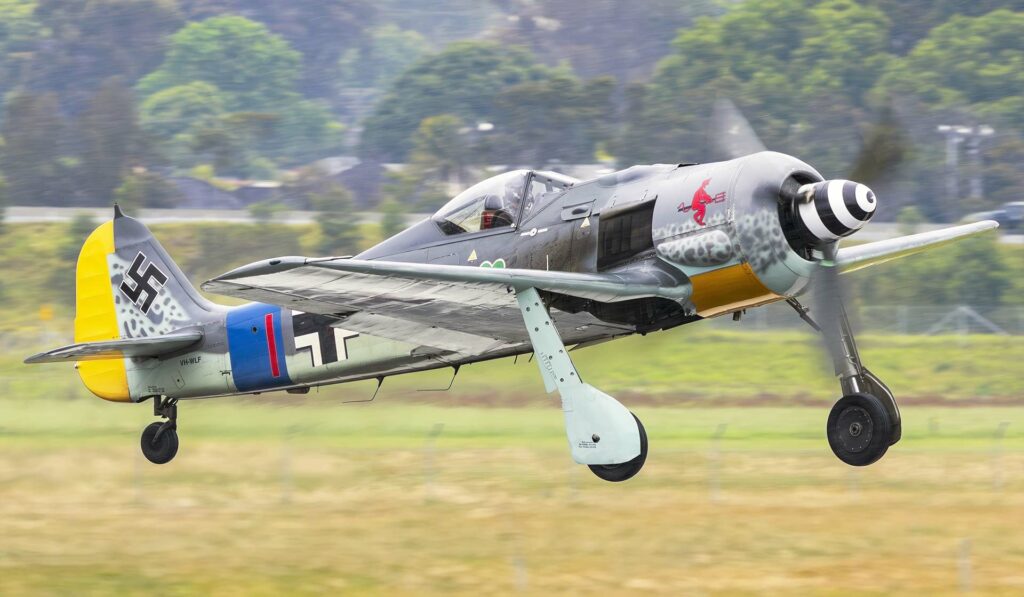The Focke-Wulf Fw 190, a WWII German fighter, boasted a radial engine, excelled in versatility, and was known for its firepower and maneuverability.
This article explores the Focke-Wulf Fw 190, a prominent German fighter aircraft of World War II. It covers the Fw 190’s development, design, performance, and military use, highlighting its role as a versatile frontline fighter, its impact on aerial combat during the war, and its competition with Allied aircraft.
The Focke-Wulf Fw 190 was a highly versatile and powerful German fighter aircraft of World War II. Known for its robustness, firepower, and performance, the Fw 190 was a key component in the Luftwaffe’s air operations. This article aims to provide an in-depth look at the development, design, operational capabilities, and combat history of the Fw 190.
History of the Development of the Focke-Wulf Fw 190
Developed in the late 1930s and early 1940s, the Fw 190 was created against a backdrop of rapid military aviation advancements. The Luftwaffe required a versatile fighter that could perform a variety of roles, including air superiority, ground-attack, and bombing missions.
The Fw 190 program was initiated by Focke-Wulf, a prominent German aircraft manufacturer, under the leadership of chief designer Kurt Tank. The goal was to create a fighter that could supplement and eventually replace the Messerschmitt Bf 109, the Luftwaffe’s primary fighter at the time. The Fw 190 made its first flight on June 1, 1939.
Its development was critical for Germany’s efforts to maintain air superiority and adapt to the evolving demands of aerial combat in World War II.
Design of the Focke-Wulf Fw 190
The Fw 190 was notable for its innovative design, featuring a radial engine – a departure from the inline engines commonly used in German fighters. This engine was a BMW 801, a 14-cylinder twin-row radial engine, providing significant power and reliability.
The aircraft’s dimensions included a length of 9 meters and a wingspan of 10.5 meters. Its design offered several advantages, such as excellent visibility for the pilot, a simplified maintenance process due to its air-cooled engine, and robust construction that could withstand significant damage.
However, the radial engine’s larger frontal area created aerodynamic challenges, and the Fw 190 initially suffered from poor high-altitude performance compared to its competitors. These issues were addressed in later versions with turbochargers and upgraded engines.

Performance of the Focke-Wulf Fw 190
In terms of performance, the Fw 190 was a formidable aircraft. It could reach speeds of up to 656 kilometers per hour (408 miles per hour) and had a service ceiling of approximately 10,000 meters (32,800 feet). The Fw 190’s range was around 800 kilometers (500 miles), making it effective for a variety of mission profiles.
When compared with contemporaries like the British Spitfire and the American P-51 Mustang, the Fw 190 was competitive, particularly in its agility, climb rate, and firepower. Its performance made it one of the most feared fighters in the Luftwaffe’s arsenal.
Military Use and Combat of the Focke-Wulf Fw 190
The Fw 190 was heavily armed, typically with a combination of machine guns and cannons. It saw extensive use in various combat roles, including as a day fighter, fighter-bomber, and ground-attack aircraft. The Fw 190 participated in major operations on both the Eastern and Western Fronts.
The aircraft excelled in air superiority missions and was equally adept in ground-attack roles. It competed fiercely with Allied aircraft, notably the Spitfire and Mustang, often gaining the upper hand in air-to-air combat due to its superior armament and agility.
The Fw 190 was used primarily by Germany and was not widely exported during the war. Post-war, the design influenced several other aircraft but was eventually phased out in favor of jet-powered fighters.
The Focke-Wulf Fw 190 remains one of the most iconic and versatile fighters of World War II. Its development, design, and combat performance reflected the pinnacle of piston-engine fighter technology. The Fw 190’s legacy is defined by its significant impact on aerial warfare during the war, showcasing the technological innovations and strategic thinking of the era.
Back to the Warbirds section.